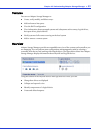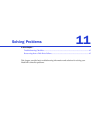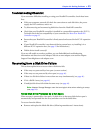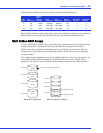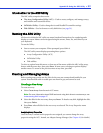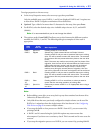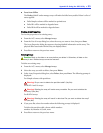
Appendix A: Understanding RAID ● 48
RAID Technology Overview
RAID is the technology of grouping several physical drives in a computer into an array that you
can define as one or more logical drives. Each logical drive appears to the operating system as a
single drive. This grouping technique greatly enhances logical-drive capacity and performance
beyond the physical limitations of a single physical drive.
When you group multiple physical drives into a logical drive, the HostRAID controller can
transfer data in parallel from the multiple drives in the array. This parallel transfer yields data-
transfer rates that are many times higher than with non-arrayed drives, enabling the system to
better meet the throughput (amount of data processed in a given amount of time) or
productivity needs of the multiple-user network environment.
The ability to respond to multiple data requests provides not only an increase in throughput,
but also a decrease in response time. The combination of parallel transfers and simultaneous
responses to multiple requests enables disk arrays to provide a high level of performance in
network environments.
Understanding Drive Segments
A drive segment is a disk drive or portion of a disk drive that is used to create an array. A disk
drive can include both RAID segments (segments that are part of an array) and available
segments. Each segment can be part of only one logical device at a time. If a disk drive is not
part of any logical device, the entire disk is an available segment.
Stripe-unit Size
With RAID technology, data is striped across an array of physical drives. This data-distribution
scheme complements the way the operating system requests data.
The granularity at which data is stored on one drive of the array before subsequent data is
stored on the next drive of the array is called the stripe-unit size.
You can set the stripe-unit size to 16, 32, or 64 KB. You can maximize the performance of your
HostRAID controller by setting the stripe-unit size to a value that is close to the size of the
system I/O requests. For example, performance in transaction-based environments, which
typically involve large blocks of data, might be optimal when the stripe-unit size is set to 32 or
64 KB. However, performance in file and print environments, which typically involve multiple
small blocks of data, might be optimal when the stripe-unit size is set to 16 KB.
The collection of stripe units, from the first drive of the array to the last drive of the array, is
called a stripe.
Selecting a RAID Level and Tuning Performance
Disk arrays are used to improve performance and reliability. The amount of improvement
depends on the application programs that you run on the server and the RAID levels that you
assign to the logical drives.
Each RAID level provides different levels of fault-tolerance (data redundancy), utilization of
physical drive capacity, and read and write performance. In addition, the RAID levels differ in
regard to the minimum and maximum number of physical drives that are supported.



